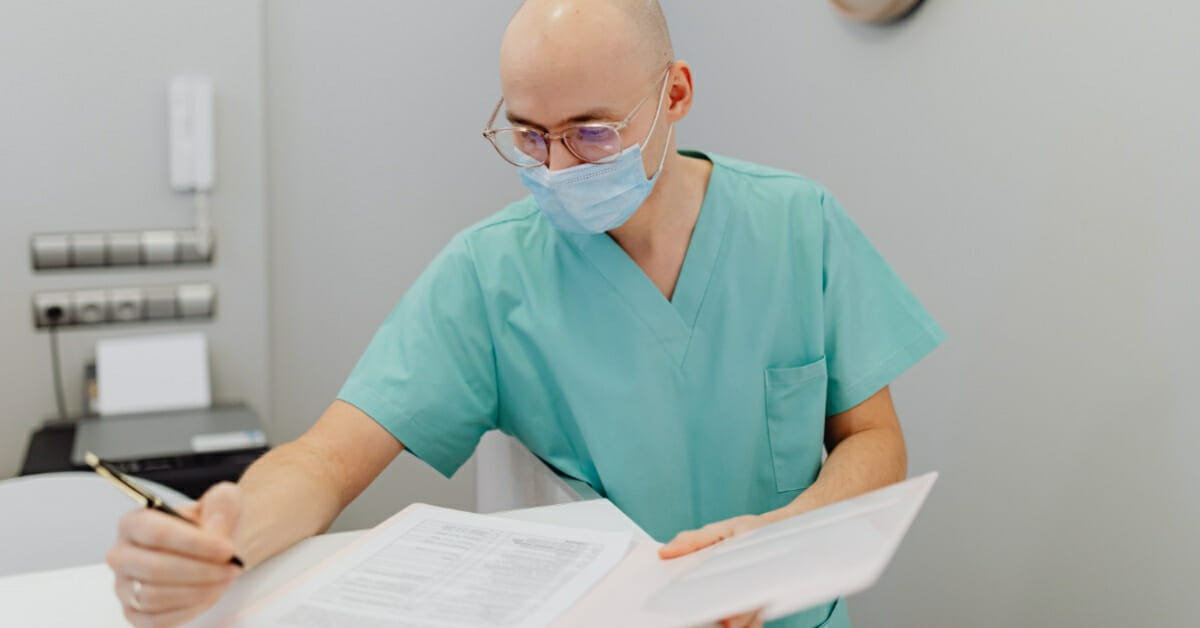In this article, I will talk about why documentation is so legally important in nursing, plus a few nursing documentation principles that have been shared with me and specific documentation advice from seasoned pros.
Legal Implications in Nursing
In nursing school, usually in the first semester, you’ll begin to see the curriculum touch on a few legal aspects of nursing. There are four main categories that have legal implications.
Malpractice
Malpractice is when a nurse operates outside the scope of their licensure or does not meet the proper standard of care based on their licensure. This means that malpractice is comparing the knowledge and responsibilities you have shown that you have acquired based on your license to whether you upheld them in the situation at hand.
Negligence
Negligence, while similar to malpractice, is a bit broader. It refers to the lack of due care or deviation from the standard of care that any person in a similar situation would provide. So, while malpractice looks at the licensure and professional status of the caregiver, negligence only takes into consideration what anyone else would do in a situation versus what you did.
Nursing ethics
Not practicing within the guidelines of the American Nurses Association’s Code of Ethics for Nurses can also have legal implications. These are standards laid out to guide nurses on values, character, and conduct within their communities.
Patient privacy
Patient privacy and confidentiality is the category where nurses can most easily make an error. There are strict federal laws (HIPAA) in the United States on what information can be shared, when, with whom, and the permissions that are required. Unfortunately, since nurses coordinate care with multiple individuals for multiple patients each shift, it is also really easy to accidentally violate patient privacy laws if you are not careful.
How Documentation Protects Your Nursing License
The nursing documentation or “charting” that you do on each of your patients multiple times throughout the shift provides proof against each of the legal implications that were mentioned above.
For example, for malpractice and negligence, your documentation says exactly what care you provided so it can easily be proven that you acted in the best interest of the patient.
In terms of ethics, your documentation of your actions shows that you are practicing ethically even if you’re not stating exact ethical principles.
Best Practices for Nursing Documentation
From my own research and professors who have passed along their knowledge, here are a few highlights that are generally considered the best practices for nursing documentation.
Mind your abbreviations
The healthcare industry as a whole is packed full of abbreviations and acronyms. Some of them are officially recognized and others could be considered slang and are not. Your facility may have additional abbreviations and acronyms that you cannot use, but even more importantly, The Joint Commission has a “Do Not Use” list that you must follow as a nurse.
Avoid diagnosis and opinions
Your scope of practice as a nurse varies from state to state, though there are certain things nurses cannot do in any state. Unless you are practicing as a licensed nurse practitioner, you cannot make a diagnosis as a registered nurse. Only nursing diagnoses are within the registered nurses’ scope of practice, so your documentation should never include a diagnosis that you have assumed.
Additionally, you must avoid including opinions in your nursing documentation. Just because you think x,y, and z doesn’t mean that you can document that. Stick to things you can observe, measure, or assess. Do not make any conclusions within your nursing documentation.
Double-check everything
Remember in elementary school and beyond when your teachers preached about double-checking your tests before turning them in? Well, their advice doesn’t just apply to tests in school.
With many electronic medical records systems that you’ll use for nursing documentation, it is easy to make selections, copy previously documented information, and in general, go through it quickly.
However, flying through your charting opens you up to making errors that could later become a problem if there were ever any legal action taken. So, though you may not have a ton of extra time in your shift, make the effort to at least double-check your documentation once.
Be truthful
A patient’s medical record, which you are contributing to each and every time you document as a nurse, is considered a legal document.
This should go without saying, but if there’s any principle of documentation that you must follow it’s to be truthful. Everything that is written into a patient’s medical record is regarded to have happened and to be accurate.
Therefore, if you didn’t do something, do not document that you did. Only document exactly what happened in any situation.
Follow facility guidelines
During the onboarding process when you get hired on as a nurse at any facility, you’ll be given a ton of paperwork that outlines all of that facility’s guidelines. It is easy to just file these things away and never think about them again. However, this information will be vital.
Facilities are overseen by government agencies and have developed their policies to reflect the requirements of those agencies. So, following your facility’s guidelines is definitely the best practice for nursing documentation.
Studying nursing has never been easier.
Set yourself up for success with Lecturio.
Documentation Advice from Veteran Nurses
Recently, I had the pleasure of talking with several veteran nurses while on clinical rotations. I had the same question for each of them: “What is your best documentation advice for new nurses to protect their license?” Below are the highlights of what they had to say.
KISS method
“I follow the KISS method. KISS stands for Keep It Simple Stupid which really just means I keep all of my documentation as simple as possible.” – Cherie S., RN
As Cherie S., RN, shared from her 11 years of bedside experience, with nursing documentation, there is no need to get fancy with it. In fact, much of the time, less is more.
When you get too wordy and start adding extra things to your nursing documentation, you are leaving more of it up to interpretation. When you think about that in terms of a courtroom, you are essentially providing room for the other side to make an interpretation and convince a jury of something even if it’s not what you actually meant.
Instead, keep your statements as simple as you can while ensuring you still provide the necessary details.
Don’t forget to document all communications
Above I mentioned how easy it can be to violate patient privacy. One related documentation tip shared by Leslie T., RN, BSN, who has more than 12 years under her belt at the bedside, was to document any and all communications:
“Anytime you call the doctor (or any member of the care team for that matter), talk to a patient’s family member, or provide patient education, document who you spoke to, their title or relation, and a description of what was discussed.” – Leslie T., RN, BSN
Of course, before you speak to anyone, double-check that you are allowed to give them information. Just because someone is an employee of the same facility you are working in, doesn’t automatically mean they can have access to patient information, so be aware of who you are talking to.
This can also be applied to visitors who ask for information that you are not permitted to share. When they ask and you decline, document who asked, when, and that you refused to share any information. If that person were to obtain the information from another way and say that they received it from you, your documentation would help prove that you were not the one that violated federal privacy laws.
Chart at the bedside when you can
In nursing school, we are always told you should document your patient at the moment when you are providing patient care. Of course, in real life, this isn’t always possible, so we tend to get in the habit of doing everything we need to do, then sitting down later to document it all.
However, Ashley B., RN, BSN, who told me she’s been providing bedside care for the last 7 years, says,“I always tell the students and newly graduated nurses I precept to make the effort to chart at the bedside when they can, and I warn them against charting in batches.”
I asked how that would look in the flow of her day, to which she gave me some examples.
One of these is how she begins her shift. She gets the bedside report and then immediately goes into each patient’s room, where she does her assessment and charts it in the room as she goes through the body systems. She completes that for each of her patients. This goes on throughout the day, so whenever she is in the room for care tasks, the documentation is done before she leaves the room.
Ashley shared that it does take her longer to assess her patients initially, but later, she doesn’t have to spend a chunk of time charting it all.
She also wanted to remind everyone that “if there are urgent things or an emergency, the care of the patient always comes first.” Essentially, don’t worry about documenting at the bedside at the moment if it is going to delay any urgent patient care.
Do your own assessments
Speaking of assessments, Carol R., RN, shared her best documentation tip from her 17 years of experience.
Carol R., RN states, “I always tell new nurses to not get lazy and copy the assessment documented from the last shift.”
You should always be doing your own assessments for each of your patients every time. For one, you shouldn’t rely on the accuracy of the last nurse. Second, a patient’s condition and presentation can change at any time. If you do not do your own assessment, you could miss something that has changed and needs to be addressed.
Don’t hesitate to use quotes
There are just some things a patient says that can’t be paraphrased.
According to Sara W., RN, BSN, who is a veteran with 5 years’ experience at the bedside, “New nurses shouldn’t be afraid to quote their patients within the nursing documentation. From my experience, quotes can provide a better representation of why you took the action you did in a difficult situation.”
This advice is particularly helpful in situations when a patient is aggressive or non-compliant.
Bottom Line
Ultimately, the reason why documentation is important in nursing is because of the legal ramifications. Nursing documentation can vary from state to state and facility to facility, but there are certain things that can be applied anywhere. Utilize the tips we have talked about today and the various resources linked throughout to ensure you protect yourself legally with your nursing documentation.




